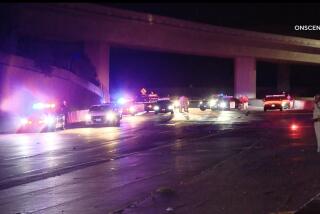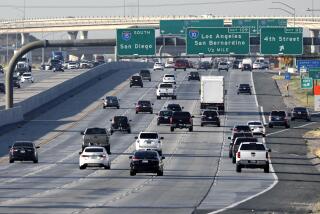Variety of Flies in the Ointment Can Trigger S.D. Freeway Snarls
- Share via
What brings traffic to a halt on San Diego County freeways?
The sight of a rhinoceros in the center median of California 163 in Balboa Park will do it. Never mind that it was only a papier-mache imitation. The sight still startled motorists--some of whom swore they saw it moving--and rattled an otherwise smooth commute.
A car dealership owner living for several days in a van--suspended from a crane high above the ground--will do it. This fellow pulls the prank every once in a while to help sell cars, and he’s in full view of motorists on Interstate 8 in La Mesa, who always slow to gawk at his gimmick.
A motorist fixing a flat tire--in the middle lane of Interstate 5 through downtown, at rush hour--will do it. The man, visiting here from Mexico with his car filled with wife and kids, didn’t think he had to pull over before jacking up his car. When California Highway Patrol Officer Fred Miller finally weaved his way through stalled traffic to discover the cause of the jam, he was almost, but not quite, too angry and incredulous to cite him.
Then there was the time that aerial traffic reporter Monica Zech was flying over Mission Valley, trying to figure out why traffic was coming to a standstill on Interstate 8 near Hotel Circle. There was no apparent accident, road hazard or heavy on-ramp traffic, but the cars were coming to a virtual halt.
She circled overhead until she finally spotted the problem: One of the motels had inflated giant balloons shaped like teddy bears as a promotional gimmick, not realizing the repercussion. Zech’s ground partner radioed the CHP, and an officer asked the motel to deflate the bears. Traffic resumed its flow.
Most of the problems on San Diego’s freeways are caused by motorists themselves and can’t be blamed on under-designed roadways, according to the state Department of Transportation, the CHP, the Automobile Club of Southern California and traffic observers.
A simple fender-bender at rush hour can bring traffic to a crawl--and keep it crawling for an hour or longer, even after the antagonists have exchanged information and driven away.
Road hazards--whether it be a mattress flying from the back of a pickup truck or a frightened dog trapped on the median--will stop motorists. Political banners hanging from bridges will slow traffic. So will a timid motorist pulling up alongside--but afraid to pass--a tractor-trailer rig.
And something as simple as motorists changing lanes in heavy traffic can bring traffic to a halt. The next motorist taps his brakes to put space between the two cars and, like a shock wave, each succeeding motorist--especially if he was tailgating--brakes abruptly until finally cars farther back begin stopping altogether. The result is an accordion effect in traffic flow--particularly noticeable from the air--that confounds motorists.
Other predictable headaches:
- A Monday night Chargers football game.
- Christmas shopping in Mission Valley.
- July Fourth in Mission Beach or at the Del Mar Fair.
- Smoke from a grass fire.
- A spin-out after the first rain of the season as motorists rediscover oil slicks and hydroplaning.
That is the stuff that causes traffic jams on San Diego County’s freeways.
Ray Granstedt, a Caltrans systems engineer whose job is to try to keep the freeways moving smoothly, said some of the best-designed and engineered freeways in the world can’t counteract poor motorist behavior. Such as?
“Motorists should not change lanes excessively. Generally, the lanes move at about the same speed, so there’s not much to be gained. But by cutting in front of another motorist when changing lanes, you’ll get the accordion action,” he said.
Some drivers are guilty, he said, of becoming dueling motorists--getting even with one another for poor driving, by cutting in front of one another or perhaps by becoming a self-appointed traffic cop--by driving 55 m.p.h. in the fast lane to try to slow speeding traffic.
“All that succeeds in doing is in getting the faster motorists to change into the slower lanes to get past you, and that creates even more problems,” he said. “Let the speeders have the fast lane, and just hope the CHP will eventually get them. It’s not your job.”
If reacting, or overreacting, to bad drivers is one source of traffic congestion, rubbernecking is perhaps an even more serious problem.
CHP Officer Lloyd Needham said, “Too many times we’ll be working a minor accident in one direction of traffic when you hear the screeching, and you’ll end up with an even worse accident on the other side of the freeway, caused by someone rubbernecking at the first incident.”
To reduce instances of rubbernecking, the CHP tells its officers to turn off their flashing lights after they pull over to the shoulder of the freeway to aid a disabled motorist or to issue a traffic citation.
“People are nosy, and they want to see what’s happening to the guy on the shoulder,” CHP spokesman Harvey Heaton said. “So we tell our officers to turn off their rear deck amber lights and to use just their four-way flashers or no lights at all. We don’t want to draw attention to us because people will slow down to look--even if it’s just a disabled car.”
CHP officers also are reluctant to make traffic stops at rush hour because of concerns that the vehicle can’t be pulled over safely or because once the violator is pulled over, rubberneckers will slow the traffic flow.
“You have to weigh it out,” Needham said. “Are you going to cause a bigger hazard by pulling him out than you would by allowing him to do what he did? Because once the rear ambers go on, traffic begins to screw up. People start watching you and saying, ‘Get him! Get him!’ And if they start watching you, they’re not watching what they should be.”
Some CHP officers will try to direct the violator to leave the freeway on the next off-ramp rather than to pull over to the shoulder.
And CHP officers pull their hair out over motorists in non-injury collisions who feel obligated to leave their vehicles in the road, rather than pulling them over to the shoulder to exchange information. There is no law that requires motorists to preserve an accident scene until the arrival of law-enforcement officers.
“Usually, there’s enough physical evidence left on the pavement for an officer to reconstruct an accident scene even if the cars themselves have been moved over to the shoulder,” Heaton said. “People should use their noggins and, if there are no injuries, get their cars off onto the shoulder.”
Motorists generally are better about pulling their disabled cars over to the shoulder, but their vehicles still add to rush-hour congestion because they are visual distractions, the CHP says.
Statistics indicate that most disabled vehicles are the result of motorist error--running out of fuel or a mechanical breakdown that could have been prevented through proper maintenance.
“If it was up to me, I’d charge every disabled motorist $50,” Needham said. “That would cure a lot of problems.”
One of CHP Officer Vinnie Brown’s chief complaints is that motorists don’t anticipate problems and, as a result, overreact with sudden braking when they need to slow down, thereby causing the accordion effect.
“People drive with a poor visual horizon,” he said. “They’ll watch 50 feet ahead, but not 300.” As a result, they drive more erratically, contributing to congestion.
Zech, who spends more than four hours every weekday flying over San Diego’s freeways as the traffic reporter for the Automobile Club of Southern California, observes:
“Some people who drive the freeways every day stop taking it seriously. They forget the basics--to use their turn signals, to watch for brake lights, to have enough gas in the tank.”
More to Read
Sign up for Essential California
The most important California stories and recommendations in your inbox every morning.
You may occasionally receive promotional content from the Los Angeles Times.










